IDS GeoRadar s r l ALADDINSK2 Ground penetrating radar User Manual MN 2005 038 12 ALADDIN ENG
IDS Ingegneria dei Sistemi SpA Ground penetrating radar MN 2005 038 12 ALADDIN ENG
aladdin sk2 user manual
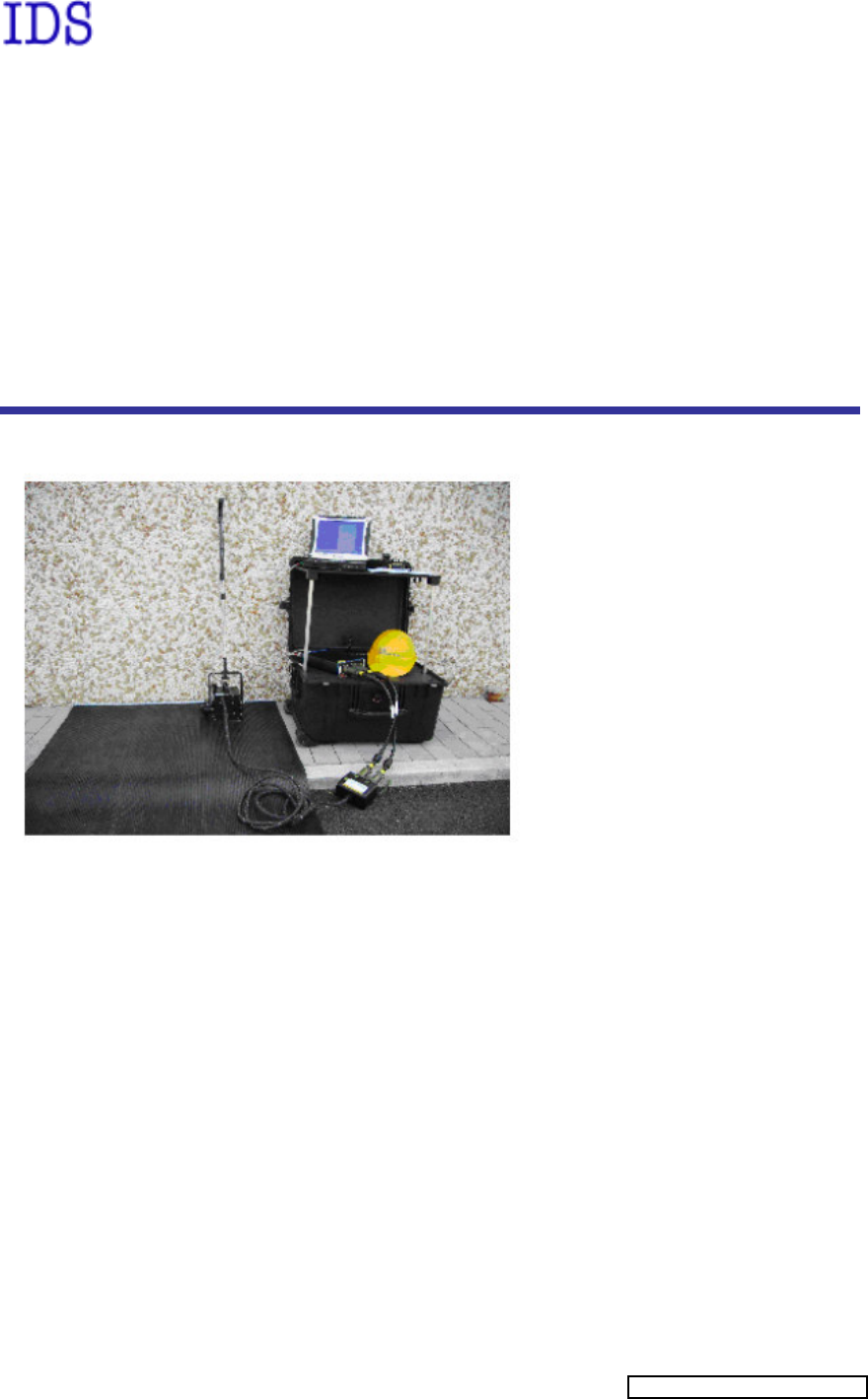
Tot pag. N°. = 32
- PRO/010/M1 Rev 3 -
INGEGNERIA DEI SISTEMI S.p.A.
Rev. 1.2
Protocol: MN/2005/038
“ALADDIN SK2” STRUCTURE KIT
USER MANUAL
Pisa, 28/06/2006
“ALADDIN SK2 ”
STRUCTURE KIT
User Manual

IDS Ingegneria Dei Sistemi S.p.A. Protocol: MN/2005/038 - Rev. 1.2
“ALADDIN SK2 ” STRUCTURE KIT User
Manual
2 / 32
Document Evolution
Revision Date Reason of change
Rev. 1.0 19/12/2005 First Edition
Rev. 1.1 28/06/2006 Upgrade of the survey kit
Rev. 1.2 25/07/2006 FCC information included
Versions covered by this document
K2 01.01.000, 01.02.000, 01.02.002.
GRED 3D 01.00.000, 01.00.001, 01.00.002, 01.03.016
Disclaimer
IDS will not be held responsible for the consequences of an improper use of the
equipment
IDS will not be responsible for the consequences caused by the improper use of the
software.
Contacts
IDS Ingegneria dei Sistemi S.p.A. – GeoRadar Division
Via Sterpulino, 20
56121 Ospedaletto (PISA) - ITALIA
Tel: +39.050.967111
Fax: +39.050.967121
inforis@ids-spa.it
Customer Care Department:
customercare.gpr@ids-spa.it
Tel.: +39.050.967122
Sales & Marketing:
sales.gpr@ids-spa.it
Tel.: +39.050.967123/24

IDS Ingegneria Dei Sistemi S.p.A. Protocol: MN/2005/038 - Rev. 1.2
“ALADDIN SK2 ” STRUCTURE KIT User
Manual
3 / 32
IMPORTANT NOTE FOR THE US CUS TOMERS
In the US this unit operates under FCC rules Part 15. According to these rules, the system
includes a manually operated switch (“dead-man switch”) that causes the transmitter to
cease operation within 10 seconds of being released by the operator.
The use of this switch is further explained in this manual; specific instructions for
operating a system sold in the US are identified by the following label
This equipment complies with part 15 of the FCC rules. Any changes or modifications not
expressly approved by the manufacturer could void the user’s authority to operate the
equipment.

IDS Ingegneria Dei Sistemi S.p.A. Protocol: MN/2005/038 - Rev. 1.2
“ALADDIN SK2 ” STRUCTURE KIT User
Manual
4 / 32
INDEX
1. INTRODUCTION .......................................................................................................6
1.1 Purpose.................................................................................................................6
1.2 Field of application...............................................................................................6
1.3 Reference ..............................................................................................................6
1.3.1 Referenced Documents ............................................................................6
1.4 Acronyms and Definitions.....................................................................................6
1.4.1 Acronyms.................................................................................................6
1.4.2 Definitions................................................................................................6
1.5 How to use this manual.........................................................................................7
2. SYSTEM COMPONENTS .........................................................................................8
3. HOW TO S ET UP THE S YS TEM.............................................................................9
3.1 Opening the case...................................................................................................9
3.2 Connecting up the system ...................................................................................13
3.2.1 How to assemble the frame to the antenna ............................................13
3.2.2 How to assemble the metric wheel to the frame ....................................14
3.2.3 Assembly of the slide on the frame........................................................14
3.2.4 How to assemble the fork and the handle on the frame .........................15
3.3 Cable connection of the system...........................................................................15
3.3.1 Complete list of cables...........................................................................15
3.4 Technical advice .................................................................................................20
4. HOW TO USE THE S YSTEM.................................................................................21
4.1 Main functions ....................................................................................................21
4.2 Work procedure using the Aladdin system .........................................................25
4.2.1 "Automatic" mode..................................................................................25
4.2.2 “M anual” Mode......................................................................................29
4.2.3 “M anual (no check)” Mode....................................................................30
PICTURES INDEX
FIG. 2-1 – “ALADDIN SK2” STRUCTURES KIT ..................................................................8
FIG. 3-1 – OPENING THE CASE...........................................................................................9
FIG. 3-2 – REMOVING THE BATTERY ..............................................................................9
FIG. 3-3 – REMOVING T HE DAD AND T HE ANT ENNA T ROLLEY .................................10

IDS Ingegneria Dei Sistemi S.p.A. Protocol: MN/2005/038 - Rev. 1.2
“ALADDIN SK2 ” STRUCTURE KIT User
Manual
5 / 32
FIG. 3-4 – REMOVING THE BIPOLAR ANTENNA............................................................10
FIG. 3-5 – BOTTOM SECTION...........................................................................................11
FIG. 3-6 – UPPER SECTION..............................................................................................11
FIG. 3-7 – INSERTING THE SUPPORT LEGS.....................................................................12
FIG. 3-8 – FIXING THE WORKTABLE...............................................................................12
FIG. 3-9 – FINAL SET-UP OF THE WORKTABLE.............................................................13
FIG. 3-10 – ASSEMBLY OF T HE FRAME ON THE ANTENNA..........................................13
FIG. 3-11 – ASSEMBLY OF THE MET RIC WHEEL ON T HE FRAME................................14
FIG. 3-12 – ASSEMBLY OF T HE SLIDE ON THE FRAME.................................................14
FIG. 3-13 – ASSEMBLY OF T HE HANDLE TO THE FRAME.............................................15
FIG. 3-14 – FIXED CONNECT ION CABLE BETWEEN T HE BIPOLAR ANTENNA
TRIGGER BOX...........................................................................................................16
FIG. 3-15 – CONNECTING T HE REMOTE CONTROL CABLE..........................................16
FIG. 3-16 – CONNECTING T HE SERIAL CABLE...............................................................17
FIG. 3-17 – CONNECTING T HE D-D CABLES...................................................................17
FIG. 3-18 – LAN CABLE.....................................................................................................18
FIG. 3-19 – POWER CABLE...............................................................................................18
FIG. 3-20 – METRIC WHEEL CABLE.................................................................................18
FIG. 3-21 – OPT ICAL DET ECTOR, CABLE AND ANTENNA CONNECTION....................19
FIG. 3-22 – SURVEY WHEEL CABLE................................................................................19
FIG. 4-1 – OPENING WINDOW K2 SW ..............................................................................21
FIG. 4-2 – EXTERNAL DEVICE SETTINGS COMMAND...................................................22
FIG. 4-3 –EXTERNAL DEVICE SETTINGS WINDOW.......................................................22
FIG. 4-4 – COM SETTINGS WINDOW ...............................................................................23
FIG. 4-5 – ALADDIN FIELD...............................................................................................23
FIG. 4-6 – INIT IAL K2 SW WINDOW WHEN USING T HE ALADDIN ST RUCTURES KIT25
FIG. 4-7 – ALADDIN SYSTEM .........................................................................................26
FIG. 4-8 – PAD FOR THE STRUCTURES KIT ....................................................................27
FIG. 4-9 – STARTING POSITION.......................................................................................27
FIG. 4-10 – ST ART BUTTONS............................................................................................28
FIG. 4-11 – SEQUENCE OF 2 SCANS USING A 2X2 PAD..................................................29
FIG. 4-12 – PSG CARPET....................................................................................................30
FIG. 4-13 – FEATURES OF PSG AND SLIDE .....................................................................31
FIG. 4-14 – GRED3D BUTTON...........................................................................................32

IDS Ingegneria Dei Sistemi S.p.A. Protocol: MN/2005/038 - Rev. 1.2
“ALADDIN SK2 ” STRUCTURE KIT User
Manual
6 / 32
1. INTRODUCTION
This manual contains a complete description of the "Aladdin"
structures kit, including details on how to assemble the kit hardware,
use it and operate the software interface
1.1 Purpose
This document is intended to be used as a guide for the installation and
use of the "Aladdin" structures kit.
1.2 Field of application
This product must only be used for applications in the civil
engineering field.
1.3 Reference
1.3.1 Referenced Documents
[RD1] MN/2004/005 (K2 Data Acquis ition Software User's guide)
[RD2] MN/2005/002 (GRED 3D Data Elaboration Software).
1.4 Acronyms and Definitions
1.4.1 Acronyms
K2: IDS georadar data acquisition software.
DAD: radar control unit
1.4.2 Definitions
Field survey: a group of field acquisitions relating to a single survey
Raw data: unprocessed data obtained during a field survey.
Maps: graphics showing the change in received radar signal (signal
intensity in gray scale) with respect to the scanning direction. These
signals must be processed to be comprehensible

IDS Ingegneria Dei Sistemi S.p.A. Protocol: MN/2005/038 - Rev. 1.2
“ALADDIN SK2 ” STRUCTURE KIT User
Manual
7 / 32
Survey: the name given to a collection of acquisitions, which together
cover all the areas of a large investigation: typically an entire town or a
large urban area.
Scan: a s ingle movement of the antenna trolley from the beginning to
the end of a pre-established path.
Data processing: this is applied to the raw data to permit the acquired
sections to be viewed in a comprehensible way.
Setup: initialisation of a piece of equipment or a software process
1.5 How to use this manual
This manual is divided into the following sections:
Chap. 1: Introduction.
Chap. 2: System composition.
Chap. 3: How to set up the system.
Chap. 4: How to use the system.
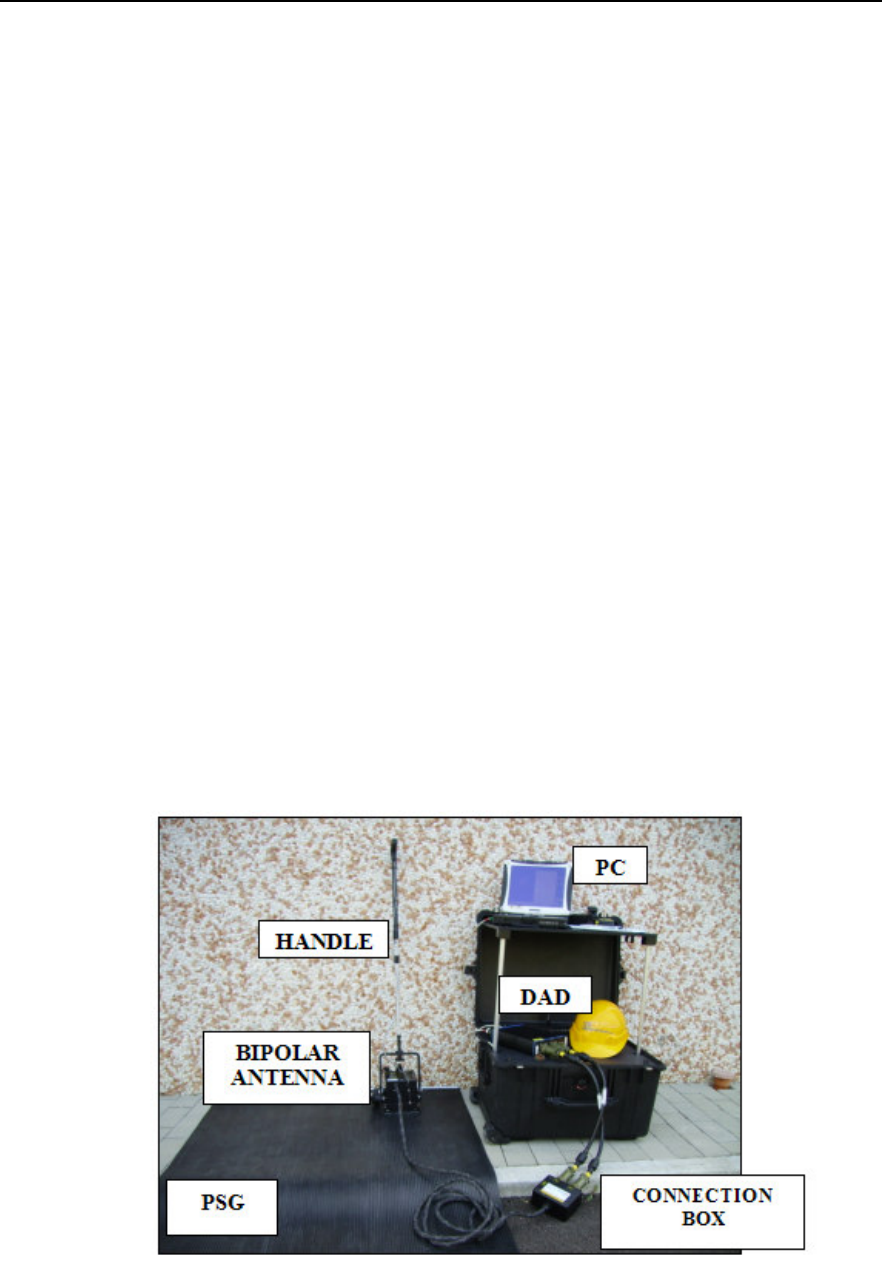
IDS Ingegneria Dei Sistemi S.p.A. Protocol: MN/2005/038 - Rev. 1.2
“ALADDIN SK2 ” STRUCTURE KIT User
Manual
8 / 32
2. SYSTEM COMPONENTS
The "Aladdin SK2" structures kit consists of the following parts:
1. bipolar antenna
2. connection box
3. trolley handle.
4. antenna trolley
5. notebook PC.
6. 2CH MCH DAD.
7. 2 cables to connect the D-D 65cm antenna to the DAD.
8. 1 battery.
9. 1 battery charger.
10. USB stick + K2 acquisition software.
11. CD-ROM + GRED 3D processing software.
12. transportation case.
13. PSG (Pad Survey Guide) carpet.
14. Optional: Kit with special trolley + optical carpet + optical reader.
Fig. 2-1 – “Aladdin S K2” structures Kit
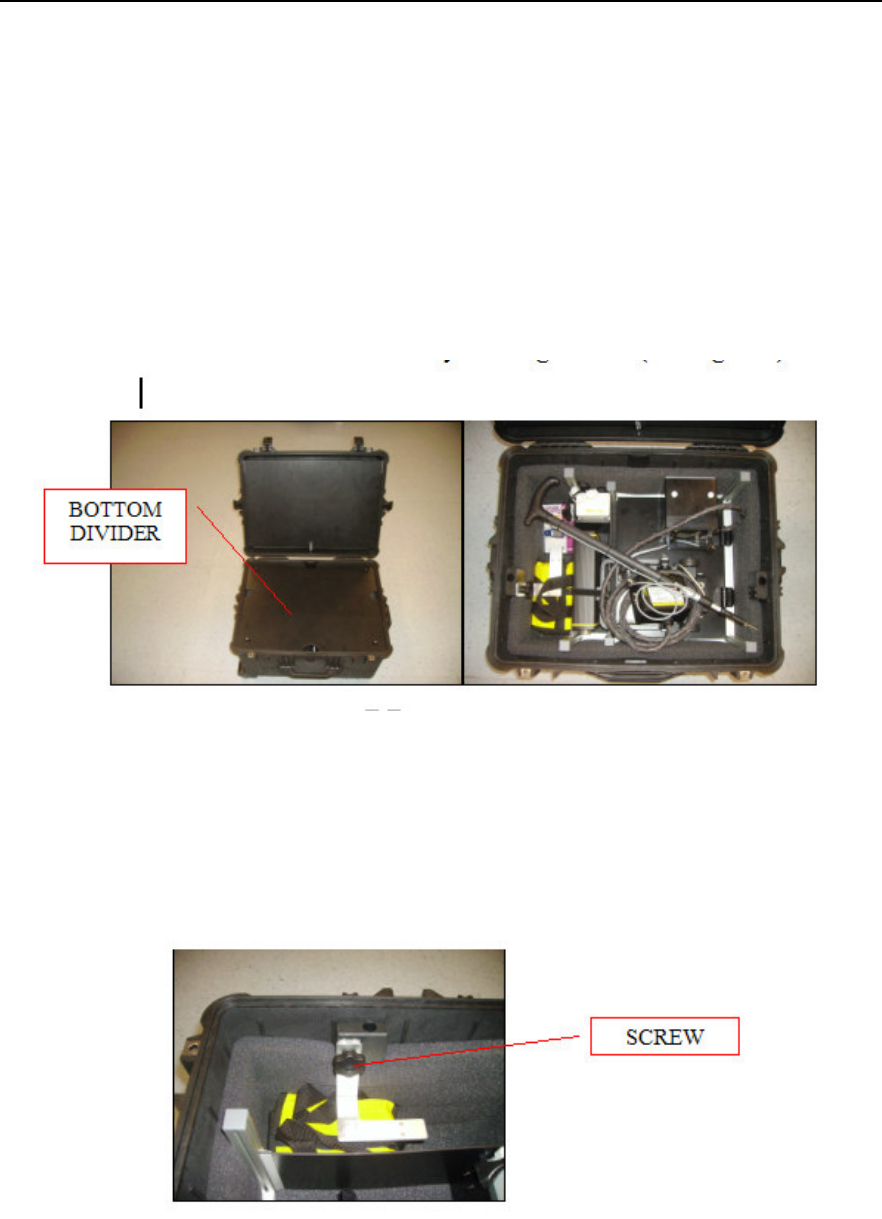
IDS Ingegneria Dei Sistemi S.p.A. Protocol: MN/2005/038 - Rev. 1.2
“ALADDIN SK2 ” STRUCTURE KIT User
Manual
9 / 32
3. HOW TO SET UP THE SYSTEM
3.1 Opening the case
When you receive the case containing the "Aladdin" structures kit,
follow the procedure below:
Open the protective case, remove the bottom divider and take
out the antenna trolley steering handle (see Fig. 3-1).
Fig. 3-1 – Opening the case
If you want to remove the battery, unscrew the black screw
shown in the picture (Fig. 3-2).
Fig. 3-2 – Removing the battery
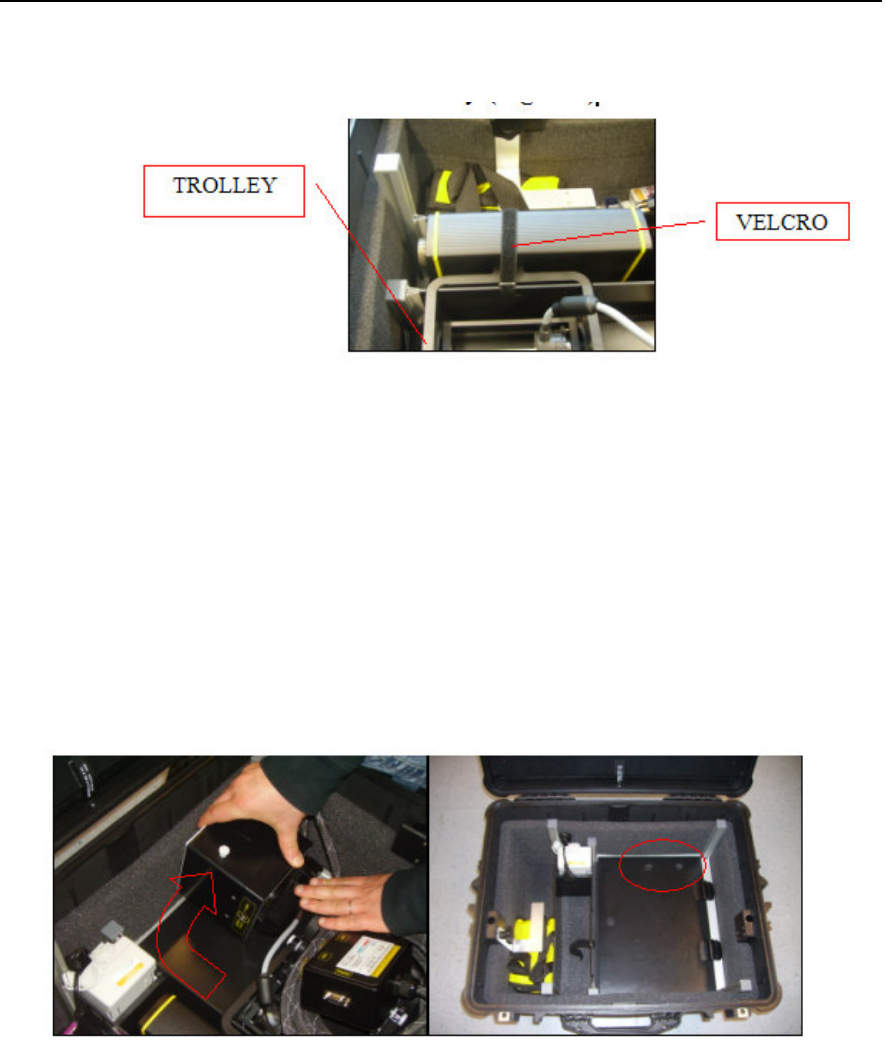
IDS Ingegneria Dei Sistemi S.p.A. Protocol: MN/2005/038 - Rev. 1.2
“ALADDIN SK2 ” STRUCTURE KIT User
Manual
10 / 32
Undo the Velcro that keeps the DAD unit blocked, now remove
the DAD and the trolley (Fig. 3-3).
Fig. 3-3 – Removing the DAD and the antenna trolley
Remove the bipolar antenna, pushing the lever towards the foam
support then lift the antenna out rotating it s lightly (see the
direction of the red arrow in Fig. 3-4); when you have to replace
the antenna in the case, be careful that the white pegs on the side
of the antenna are blocked into the two holes inside the case
(indicated with the red circle).
.
Fig. 3-4 – Removing the bi polar antenna
Open the bottom section (Fig. 3-4 and Fig. 3-5); this is the PC
storage area; if a PC has not been supplied with your order, you
can store your own PC here using the pre-cut foam to model a
suitably shaped space (Fig. 3-5). The maxim space available for
storing a PC is 34cm x 27cm x 5cm
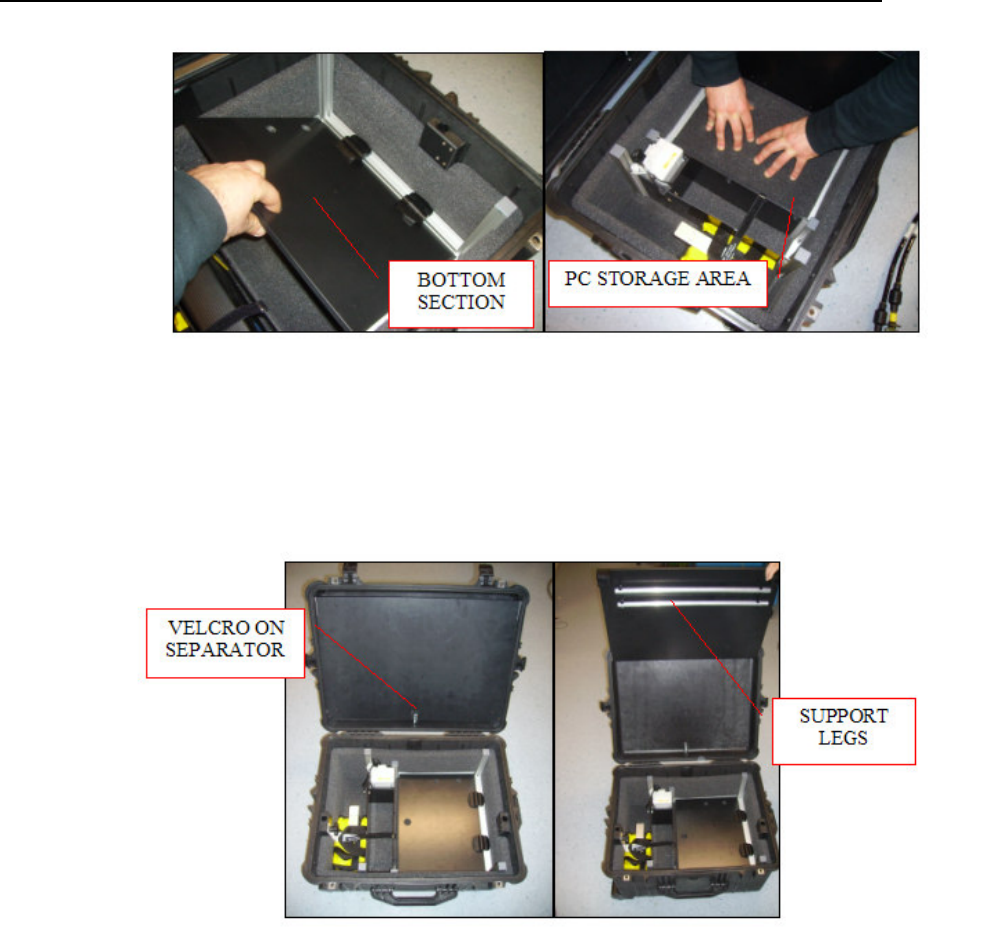
IDS Ingegneria Dei Sistemi S.p.A. Protocol: MN/2005/038 - Rev. 1.2
“ALADDIN SK2 ” STRUCTURE KIT User
Manual
11 / 32
Fig. 3-5 – Bottom section
Undo the Velcro on separator of the top part of the case and lift
up the top section (Fig. 3-6).
Fig. 3-6 – Upper section
Remove the two support legs and insert them in the holes in the
bottom of the case (Fig. 3-7).
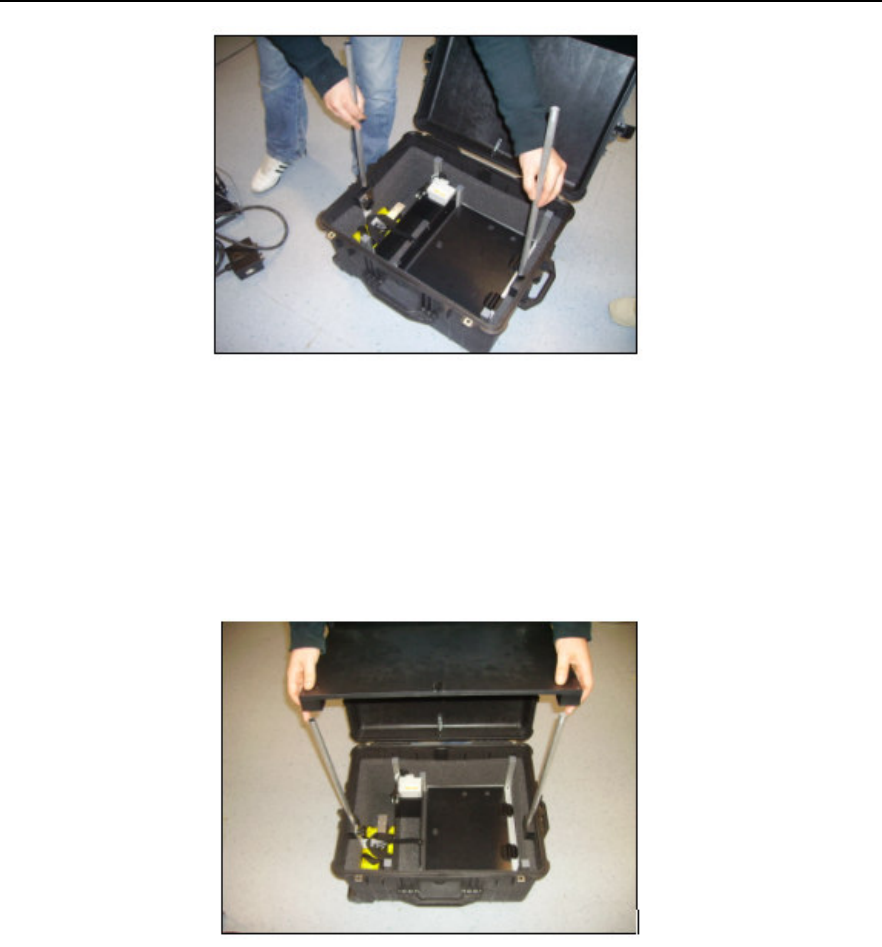
IDS Ingegneria Dei Sistemi S.p.A. Protocol: MN/2005/038 - Rev. 1.2
“ALADDIN SK2 ” STRUCTURE KIT User
Manual
12 / 32
Fig. 3-7 – Inserting the support legs
Close the lid of the case, inserting the legs into the upper
supports (Fig. 3-8).
Fig. 3-8 – Fixing the worktable
Connect the power cable to the battery then replace the lower
cover onto the case to provide a second surface for sitting the
material from the kit (Fig. 3-9).
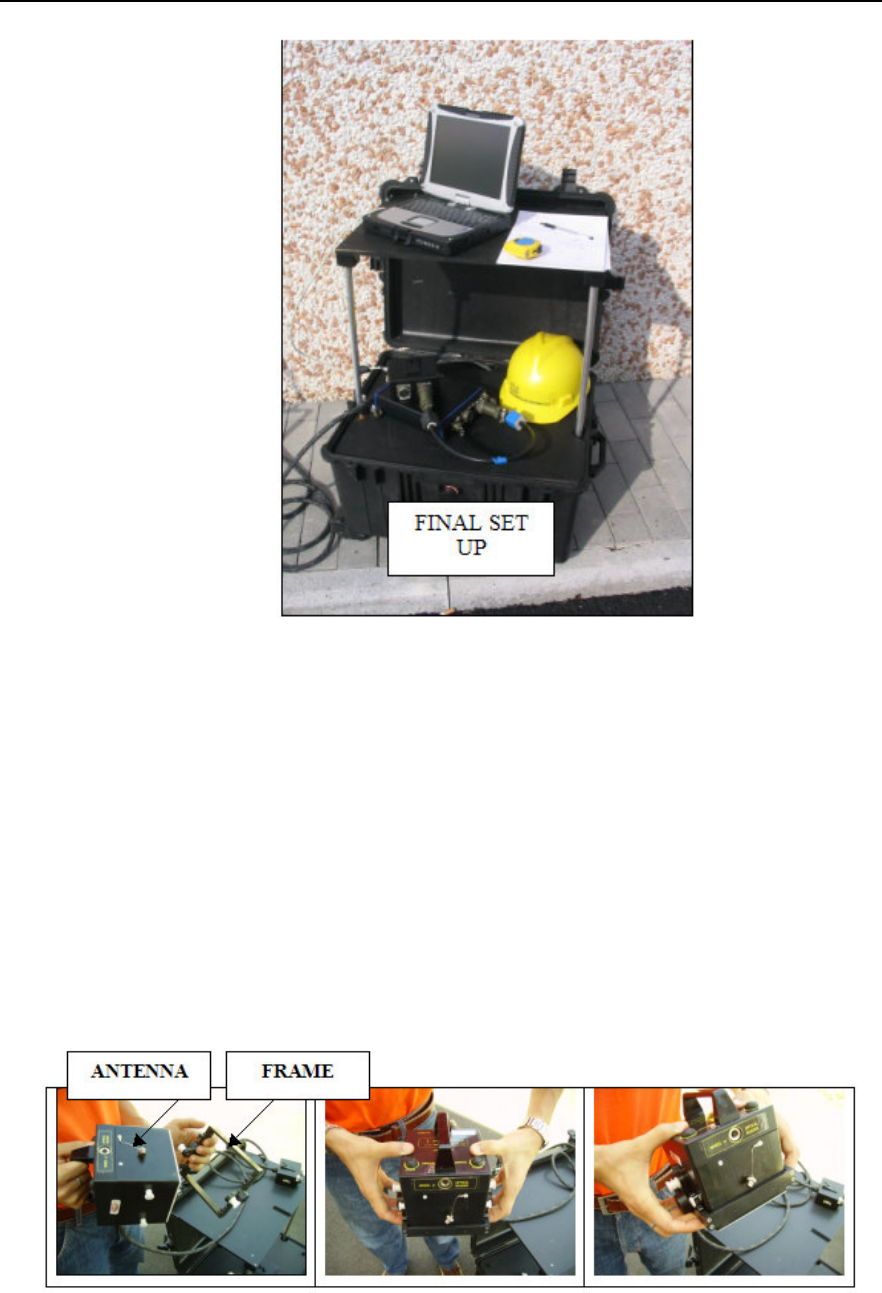
IDS Ingegneria Dei Sistemi S.p.A. Protocol: MN/2005/038 - Rev. 1.2
“ALADDIN SK2 ” STRUCTURE KIT User
Manual
13 / 32
Fig. 3-9 – Final set-up of the worktable
3.2 Connecting up the system
3.2.1 How to assemble the frame to the antenna
As we can notice from the Fig. 3-10 the procedure of assembly of the
frame on the antenna is the following:
• Link the frame as indicated in the pictures below and then push
it up in order to connect it in the lateral white nuts.
Fig. 3-10 – Assembly of the frame on the antenna
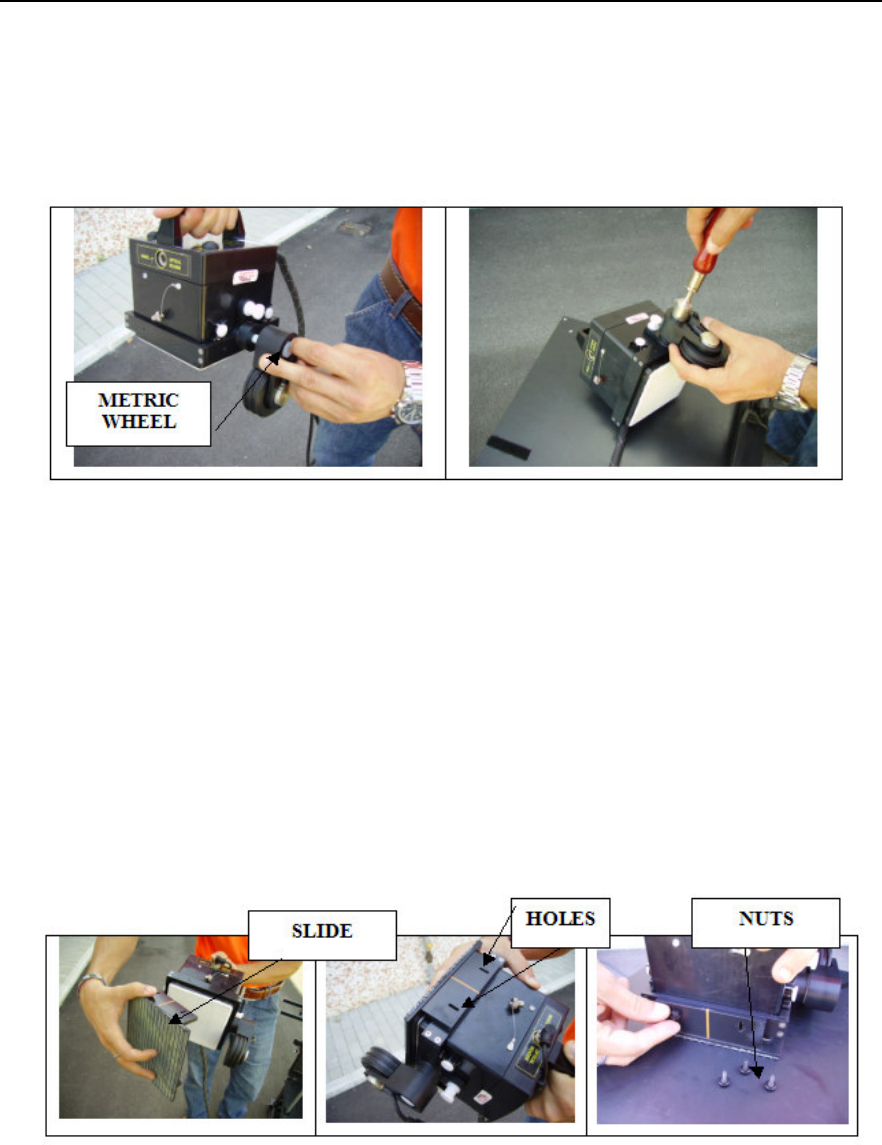
IDS Ingegneria Dei Sistemi S.p.A. Protocol: MN/2005/038 - Rev. 1.2
“ALADDIN SK2 ” STRUCTURE KIT User
Manual
14 / 32
3.2.2 How to assemble the metric wheel to the frame
• Screw the central nut of the metric wheel in the lateral hole
located on the frame, keeping the wheel in vertical position (see
Fig. 3-11).
Fig. 3-11 – Assembly of the metric wheel on the frame
3.2.3 Assembly of the slide on the frame
• Put the slide under the antenna fitting the two lateral holes
located on the front and back side of the antenna as indicated in
Fig. 3-12. The slide holds a special film PSG type (Pad Survey
Guide) in order to use it only in combination with the PSG
carpet (see Par 4.2.3).
• Screw the four nuts to the relative holes.
Fig. 3-12 – Assembly of the slide on the frame
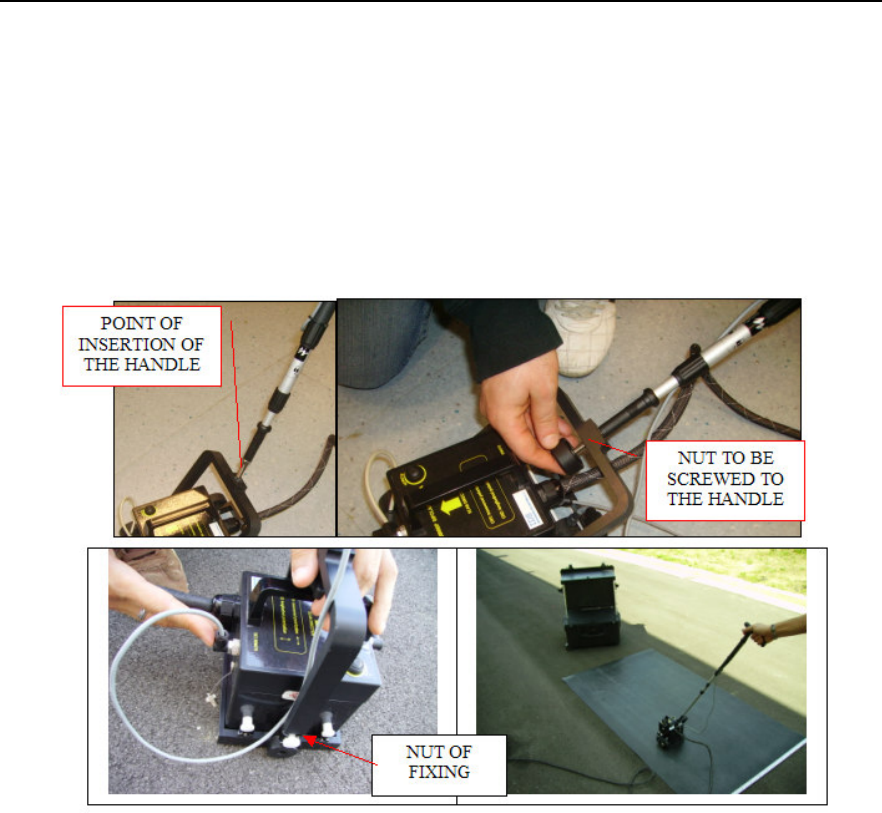
IDS Ingegneria Dei Sistemi S.p.A. Protocol: MN/2005/038 - Rev. 1.2
“ALADDIN SK2 ” STRUCTURE KIT User
Manual
15 / 32
3.2.4 How to assemble the fork and the handle on the frame
• In order to assemble the handle it’s necessary to insert the
fork at the end of the handle in the point indicated in Fig.
3-13 and then screw the nut.
• Then connect the fork of the handle to the frame making
pressure on the two white lateral nuts up to link them.
Fig. 3-13 – Assembly of the handle to the frame
3.3 Cable connection of the system
3.3.1 Complete list of cables
The following list contains all the structures kit cables and how they
are connected:
Fixed connection between the bipolar antenna trigger box (Fig.
3-14);
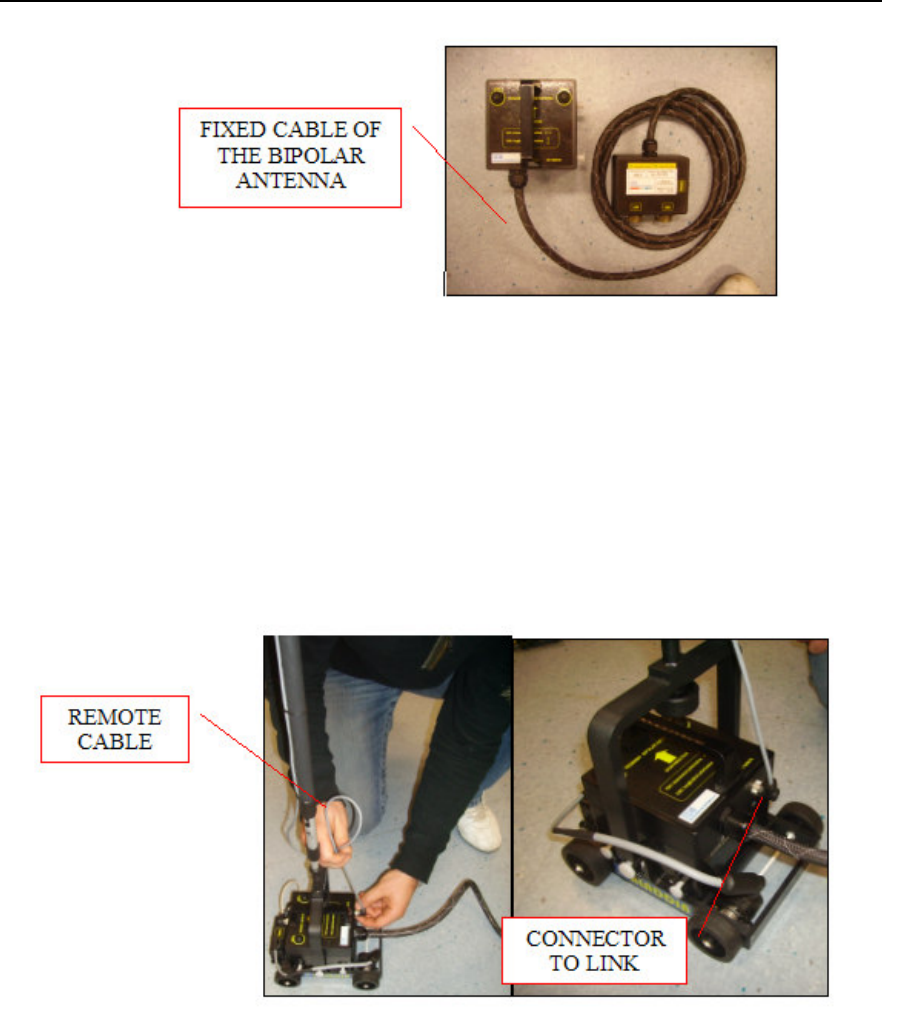
IDS Ingegneria Dei Sistemi S.p.A. Protocol: MN/2005/038 - Rev. 1.2
“ALADDIN SK2 ” STRUCTURE KIT User
Manual
16 / 32
Fig. 3-14 – Fixed connection cable between the bi polar antenna
trigger box
Remote control cable connecting the antenna to the handle (Fig.
3-15); after inserting and tightening the handle screw to the fork
connected to the antenna, connect the handle cable to the port
situated on the back of antenna labelled "REMOTE" (Fig. 3-15).
Fig. 3-15 – Connecting the remote control cable
Serial cable connecting the PC to the distribution box (Fig.
3-16); connect the serial cable to the serial port of the trigger
box and the PC (Fig. 3-16).
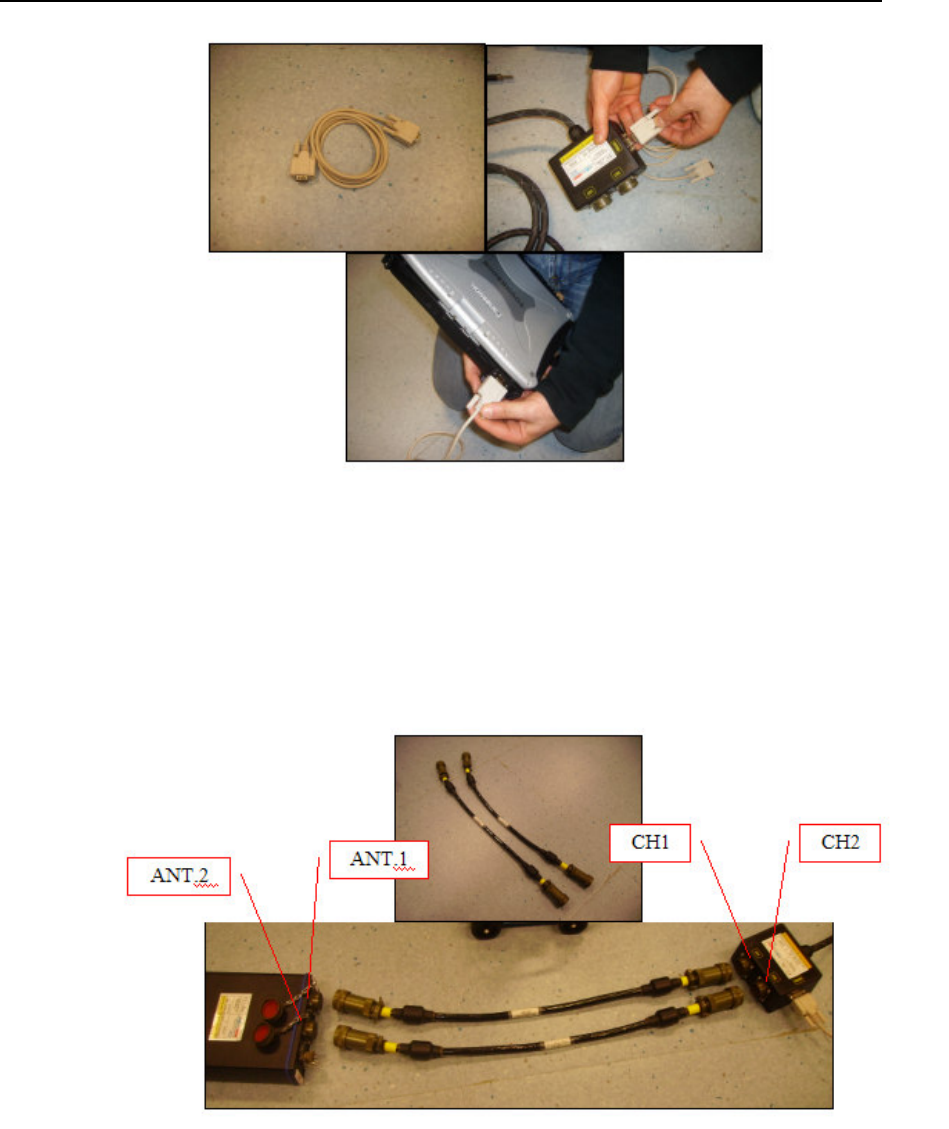
IDS Ingegneria Dei Sistemi S.p.A. Protocol: MN/2005/038 - Rev. 1.2
“ALADDIN SK2 ” STRUCTURE KIT User
Manual
17 / 32
Fig. 3-16 – Connecting the serial cable
2 65cm D-D cables connecting the trigger box to the DAD (Fig.
3-17); connect the cables respectively to the ports ANT.1 CH1
and ANT.2 CH2 indicated on the DAD and on the trigger box
Fig. 3-17 – Connecting the D-D cables
LAN cable connecting the PC to the DAD (Fig. 3-18); connect
the large LAN connector to the port on the DAD and the other
end to the smaller port on the back of the PC;
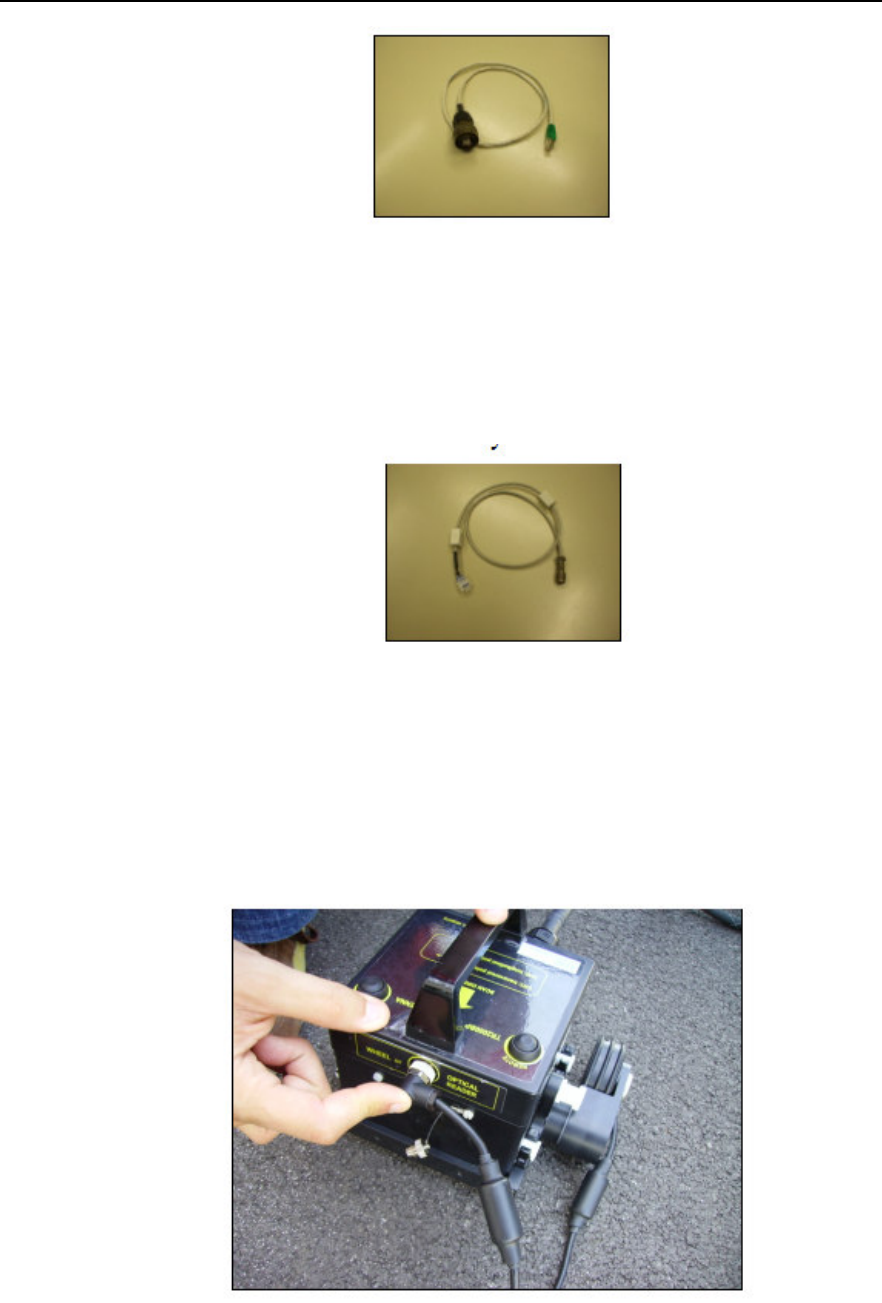
IDS Ingegneria Dei Sistemi S.p.A. Protocol: MN/2005/038 - Rev. 1.2
“ALADDIN SK2 ” STRUCTURE KIT User
Manual
18 / 32
Fig. 3-18 – LAN cable
Cable connecting the battery power supply to the DAD (Fig.
3-19); connect the metallic connector to the DAD and the white
plastic connector to the battery.
Fig. 3-19 – Power cable
Metric wheel cable: connect the cable of the metric wheel to the
WHEEL port located on the front side of the antenna (Fig.
3-20).
Fig. 3-20 – Metric wheel cable
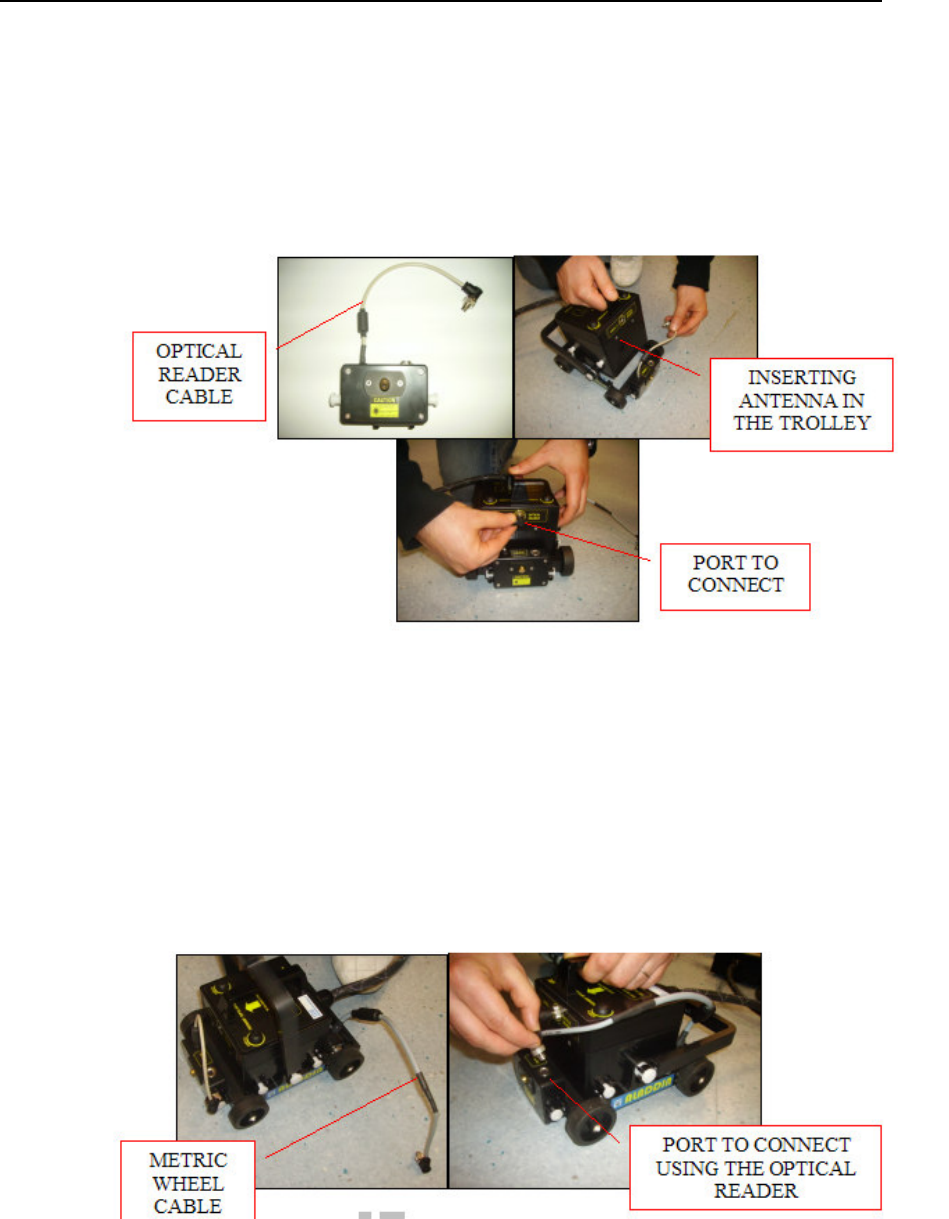
IDS Ingegneria Dei Sistemi S.p.A. Protocol: MN/2005/038 - Rev. 1.2
“ALADDIN SK2 ” STRUCTURE KIT User
Manual
19 / 32
(Optional) Optical reader cable (Fig. 3-21); after having inserted
the bipolar antenna in the trolley as shown in Fig. 3-21, connect
the optical reader cable to the port labelled "OPTICAL
READER".
Fig. 3-21 – Optical detector, cable and antenna connection
(Optional) Antenna survey wheel cable (Fig. 3-22); connect the
survey wheel cable to the port positioned on the optical detector
if one is being used. If an optical detector is not being used, the
survey wheel cable must be connected to the port on the front of
the bipolar antenna (Fig. 3-22).
Fig. 3-22 – Survey wheel cable

IDS Ingegneria Dei Sistemi S.p.A. Protocol: MN/2005/038 - Rev. 1.2
“ALADDIN SK2 ” STRUCTURE KIT User
Manual
20 / 32
3.4 Technical advice
Pay special attention to the following technical advice to avoid
operational problems:
Fix the pad to the surface being investigated with adhesive tape.
Avoid treading on the paper pad, this may damage it making it
unusable.
Block the antenna cable to the handle with Velcro when using
the device so the cable doesn't get in the way
If a high frequency antenna is being used, it must be connected
to the trigger boxand the trigger box to the DAD using the D-D
cable.
The optical detector device isn't waterproof therefore it
shouldn't be used in damp conditions.
When the optical detector is in use, don't look at the laser beam.
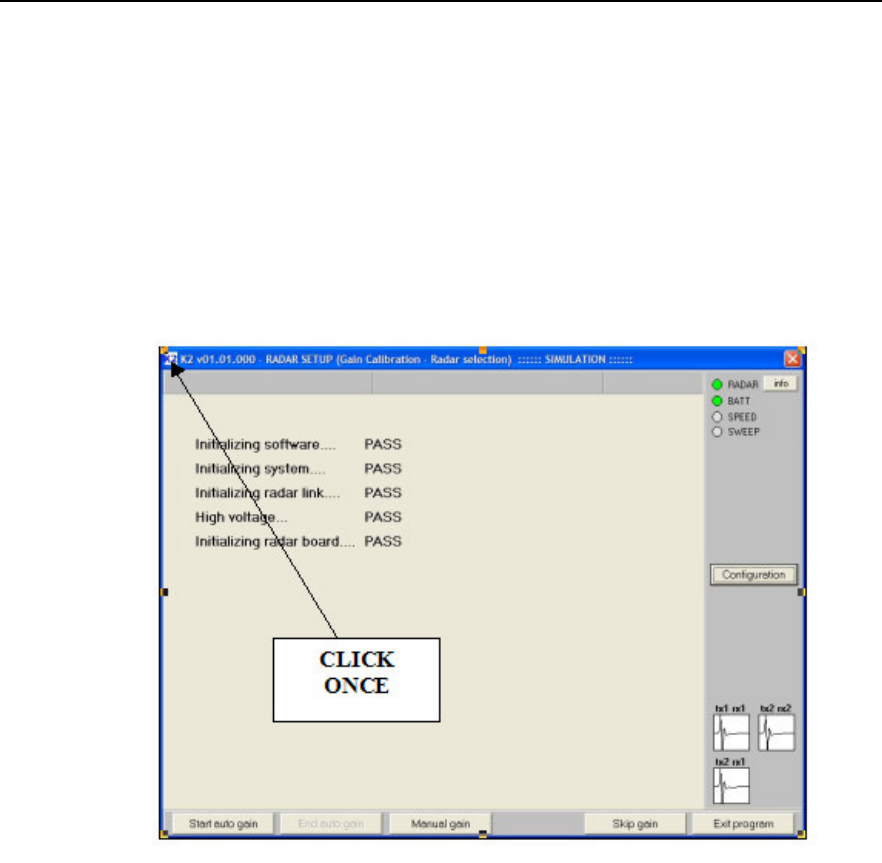
IDS Ingegneria Dei Sistemi S.p.A. Protocol: MN/2005/038 - Rev. 1.2
“ALADDIN SK2 ” STRUCTURE KIT User
Manual
21 / 32
4. HOW TO USE THE SYSTEM
4.1 Main functions
To access the "Aladdin" structures kit from the K2 SW (see
MN_2004_005), you have to open a dedicated session.
Fig. 4-1 – Opening window K2 SW
Step 1 Click once with the left mouse button on the "K2" icon
contained in the blue bar at the top of the initial K2 SW window (see
Fig. 4-1). A series of options appears, from which you have to select
External device settings (see Fig. 4-2)
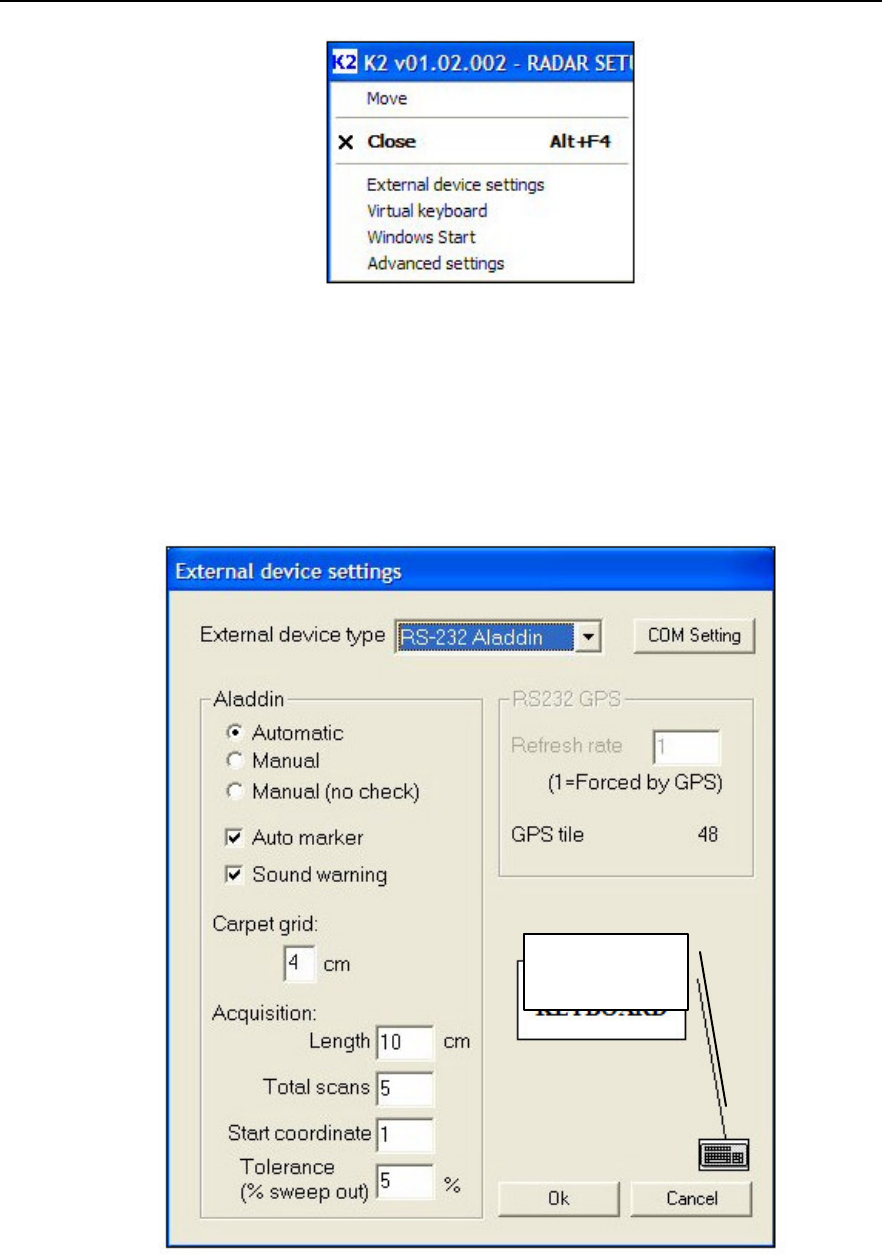
IDS Ingegneria Dei Sistemi S.p.A. Protocol: MN/2005/038 - Rev. 1.2
“ALADDIN SK2 ” STRUCTURE KIT User
Manual
22 / 32
Fig. 4-2 – External device settings command
Step 2 this opens the window shown in Fig. 4-3, select RS-232
Aladdin in the External device type field. CLICK ONCE
Fig. 4-3 –External device settings Window
VIRTUAL
KEYBO ARD
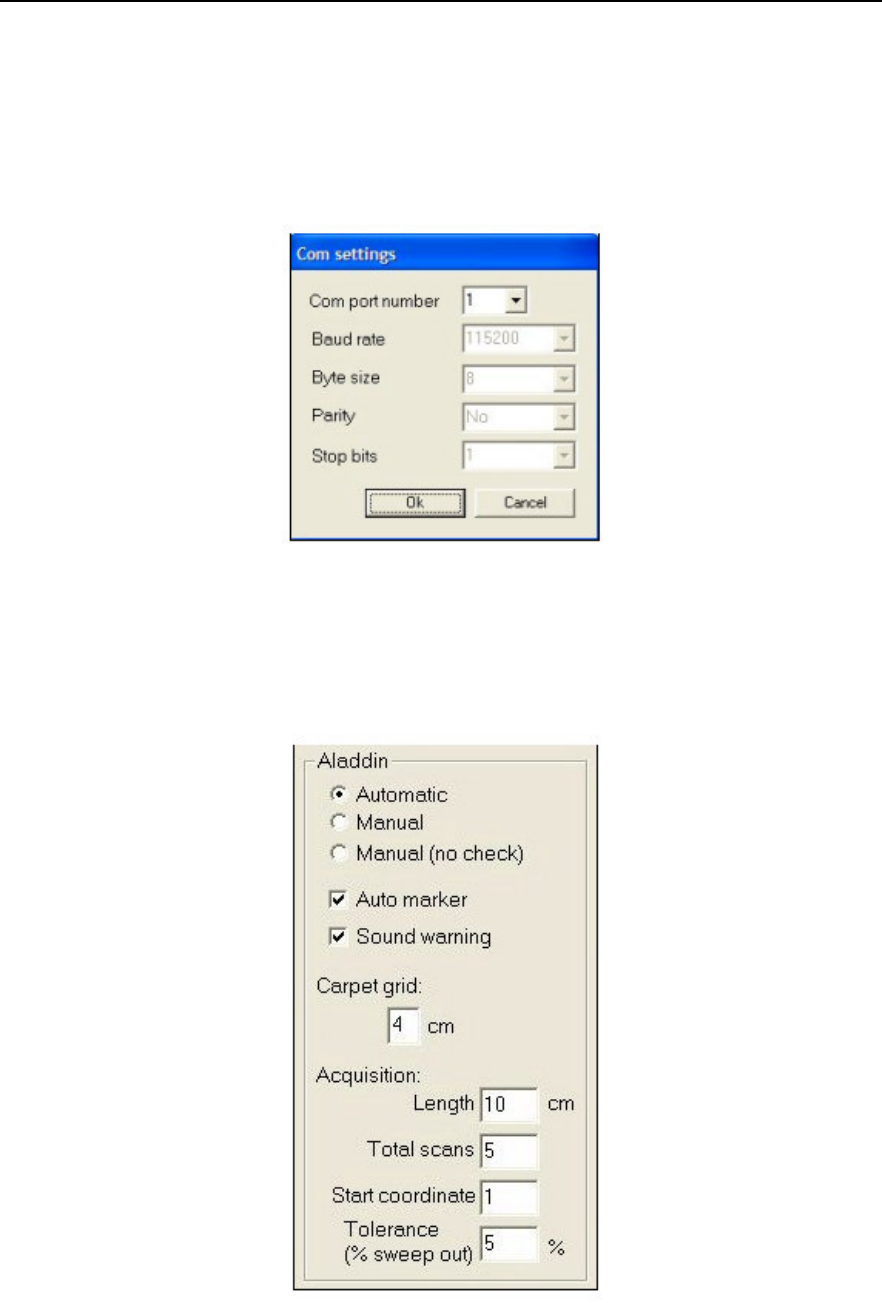
IDS Ingegneria Dei Sistemi S.p.A. Protocol: MN/2005/038 - Rev. 1.2
“ALADDIN SK2 ” STRUCTURE KIT User
Manual
23 / 32
Step 4 Click on the COM Settings button. This will open the window
shown in Fig. 4-4, from where you just have to select the Com port
number you have used to connect the kit to the structure, then press the
OK button
Fig. 4-4 – Com settings Window
Step 5 Use the Aladdin field shown in the window in Fig. 4-3 to set
the acquisition parameters to be used with the structures kit (see Fig.
4-5):
Fig. 4-5 – Aladdin Field

IDS Ingegneria Dei Sistemi S.p.A. Protocol: MN/2005/038 - Rev. 1.2
“ALADDIN SK2 ” STRUCTURE KIT User
Manual
24 / 32
The Aladdin field consists of the following parameters: ·
Automatic: an automatic acquisition mode in which once the
other parameters have been set, it is sufficient to press start,
stop and any automatic user markers, positioning the system
just before the horizontal line shown on the pad. This mode
contains automatic data quality control (see the Tolerance
field later on).
Manual: in this mode, once you start, the acquisition is
performed independently of the position of the antenna with
respect to the pad. This mode also contains automatic data
quality control (see the Tolerance field later on).
Manual (no check): this acquisition mode has no type of
automatic data quality control, and leaves you free to acquire
data as you wish. In this case, the system limits itself to
providing an acoustic warning if the system is not following
the pre-established scan path. It is also possible to make
acquisitions without using the optical reader.
Auto marker: this sets an automatic user marker each time
the antenna crosses a horizontal line on the pad
Carpet grid: this represents the size of each square that the
optical detector signals with user markers on the pad; e.g.
2cm represents a 2x2cm square, while 4cm represents a
4x4cm square and so on.
Acquisition:
Length: this represents the length of the pass you intend
to perform on the pad..
Total scans: this represents the total number of passes
that you intend to perform starting from the initial
coordinate indicated on the pad.
Start coordinate: this represents the initial acquisition
coordinate shown on the pad..
Tolerance (% sweep out): this is the factor that controls
the quality of acquired data; this factor controls how
much road is covered by the antenna with respect to the
pre-set value and if the path length is greater than your
user set percentage error. In Automatic mode, if this value
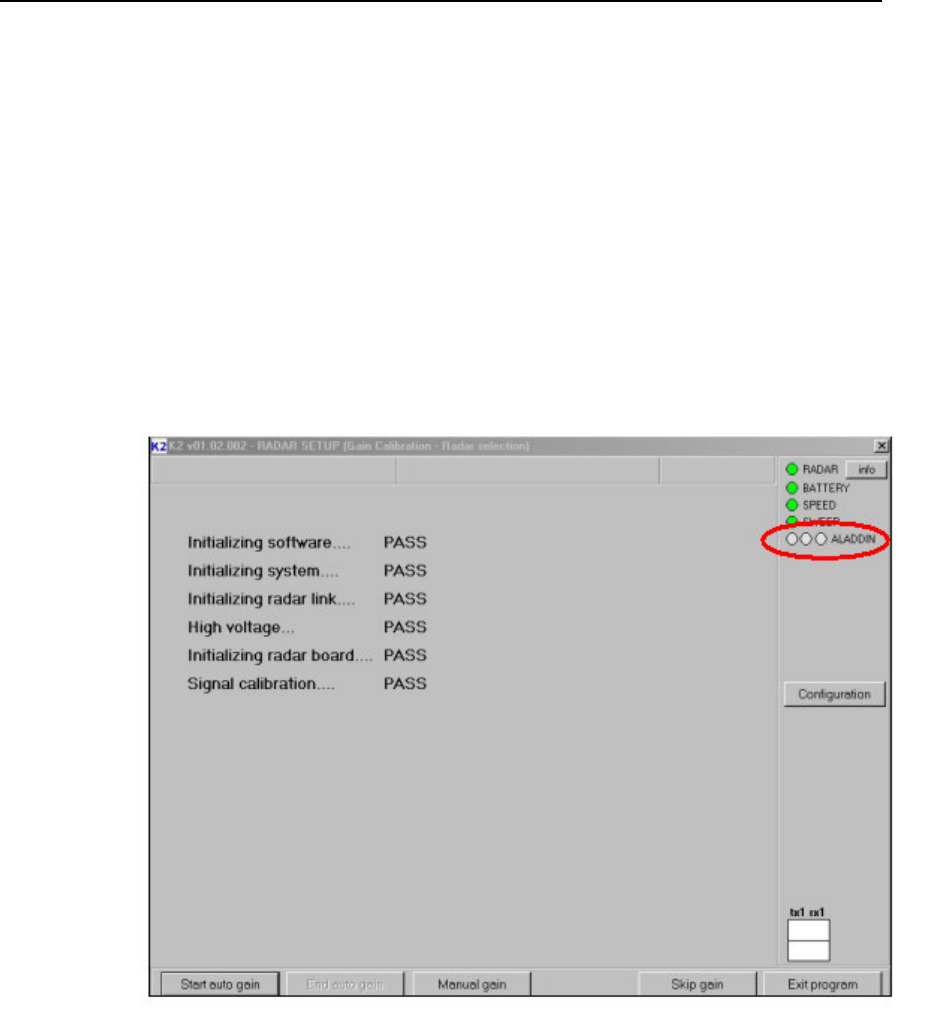
IDS Ingegneria Dei Sistemi S.p.A. Protocol: MN/2005/038 - Rev. 1.2
“ALADDIN SK2 ” STRUCTURE KIT User
Manual
25 / 32
is exceeded, the software forces you to repeat the pass
being performed.
You also have the option of calling up the virtual keyboard by pressing
the button shown in Fig. 4-3.
To confirm all the set parameters, press the OK button in the window
shown in Fig. 4-3.
Confirmation that Aladdin has been activated is given in the initial K2
SW window, with ALADDIN shown under the other lights (circled in
Fig. 4-6 in red) accompanied with three of its own lights which
simulate the three infrared sensors that make up the optical reader.
Fig. 4-6 – Initial K2 SW window when using the Aladdin structures kit
4.2 Work procedure using the Aladdin system
4.2.1 "Automatic" mode
Step 1: Assemble the system (see Fig. 4-7), and place the pad on the
surface to be investigated (Fig. 4-8).
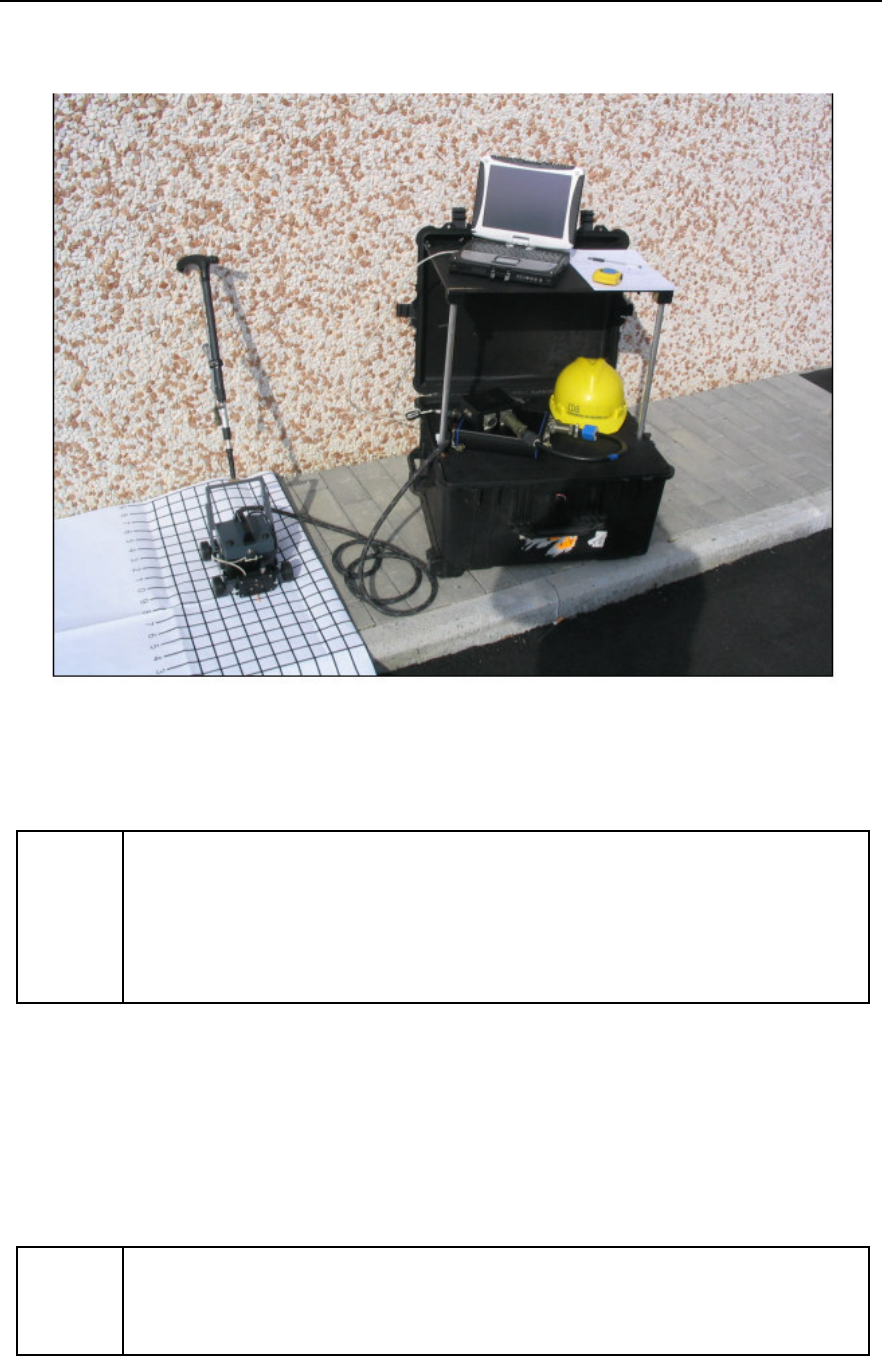
IDS Ingegneria Dei Sistemi S.p.A. Protocol: MN/2005/038 - Rev. 1.2
“ALADDIN SK2 ” STRUCTURE KIT User
Manual
26 / 32
Fig. 4-7 – Aladdin System
NO TE! The pad consists of a grid of longitudinal and transversal lines
that indicate the profiles to be traced using the antenna. In
addition, there is a black square at the bottom right hand corner
which represents the antenna
parking area, containing an optical
detector that temporarily deactivates the acoustic signal.
Step 2: Start the K2 SW, perform the calibration (as described in Par.
4.2 and 4.3 of MN_2004_005) and set the Aladdin structures kit
parameters (as described in Par. 4.1 of this manual).
NO TE! If you are using a bipolar antenna, only longitudinal scans must
be performed; for a single high frequency antenna, perform both
longitudinal and transversal scans
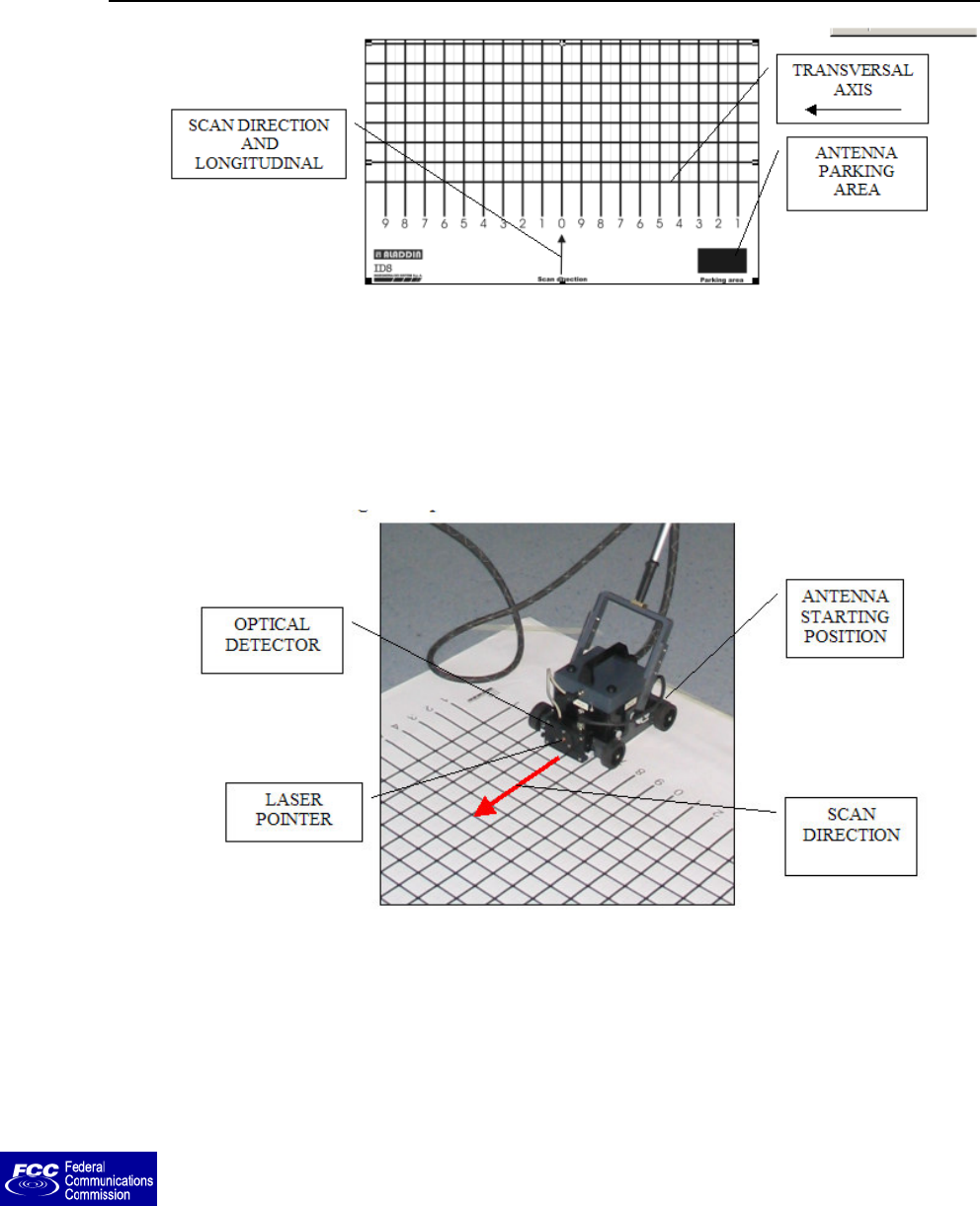
IDS Ingegneria Dei Sistemi S.p.A. Protocol: MN/2005/038 - Rev. 1.2
“ALADDIN SK2 ” STRUCTURE KIT User
Manual
27 / 32
Fig. 4-8 – Pad for the structures kit
Step 3: Position the antenna on the initial preset coordinate (Fig. 4-9)
in the L (or T) direction and carefully position the antenna until the
acoustic signal stops
Fig. 4-9 – Starting position
Step 4A (Standard System): Press one of the START buttons placed
on the handle or directly on the antenna (Fig. 4-10); a special acoustic
signal will confirm that the START button has been pressed
Step 4B (US System): Press one of the START buttons placed on the
handle or directly on the antenna and keep it pressed (Fig. 4-10); a
special acoustic signal will confirm that the START button has been
pressed. Releasing the button, will stop the collection after 10 sec.
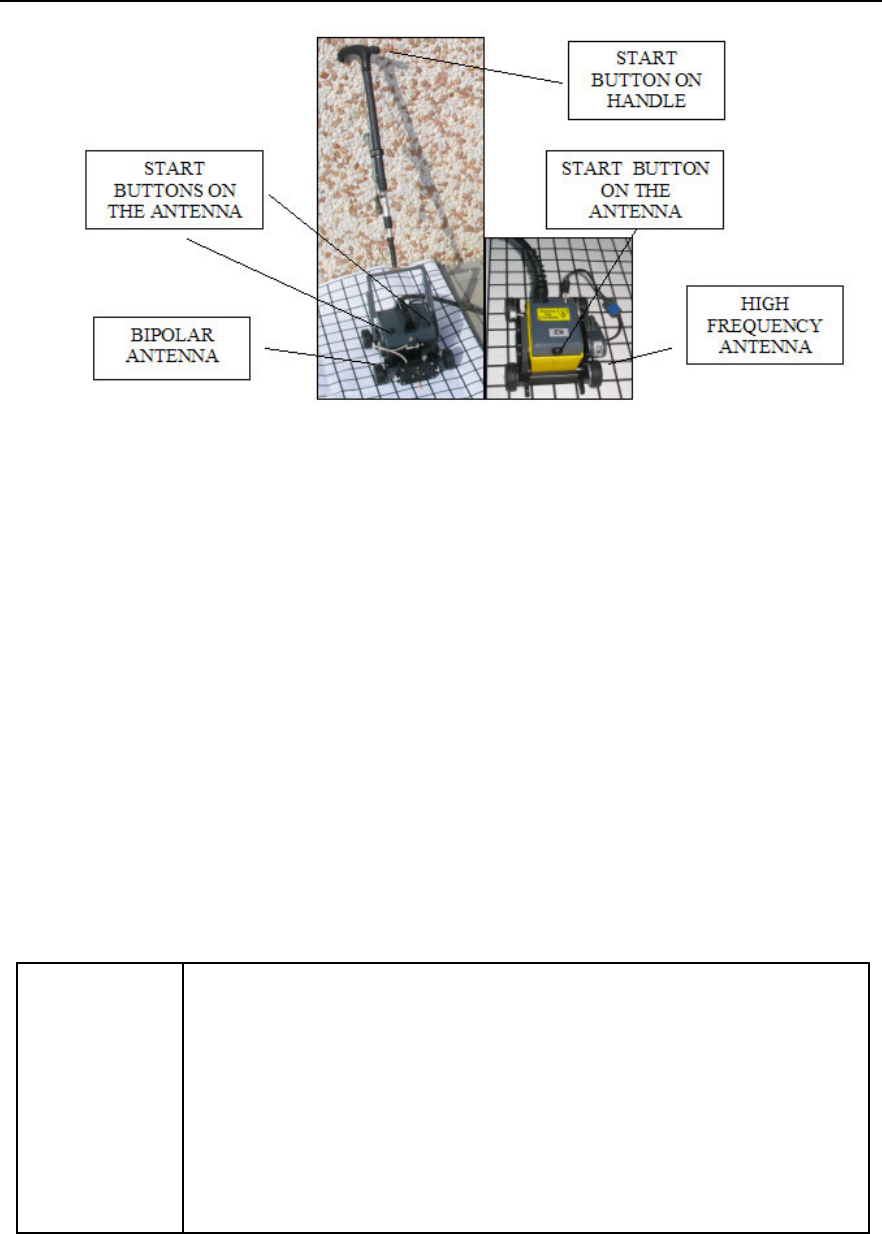
IDS Ingegneria Dei Sistemi S.p.A. Protocol: MN/2005/038 - Rev. 1.2
“ALADDIN SK2 ” STRUCTURE KIT User
Manual
28 / 32
Fig. 4-10 – START buttons
Step 5: Move the antenna in the pre-established direction; acquisition
will start as soon as the optical detector crosses the first horizontal
line.
Step 6: If you have pre-set "Auto Marker", each time the antenna
crosses a horizontal line, the system will insert a User Marker on the
scan.
Step 7: The scan will be automatically STOPPED as soon as the
optical detector encounters the last horizontal line pre-set by the
operator on the basis of the set scan Length.
Step 8: Continue the procedure described from step 3 onwards on the
next pre-set coordinate.
WARNI NG!
There is one particular case where you must pay attention:
if you use a 2x2 pad, the optical detector must carefully
follow a thick line f
ollowed by a fine line, the fine lines
being indicated with the extension F (see for example Fig.
4-11 which shows increasing coordinates (e.g. 1, 1F, 2, 2F
and so on). In Automatic
mode, you have to keep alignment
under control during scanning, making use
of the laser
pointer.
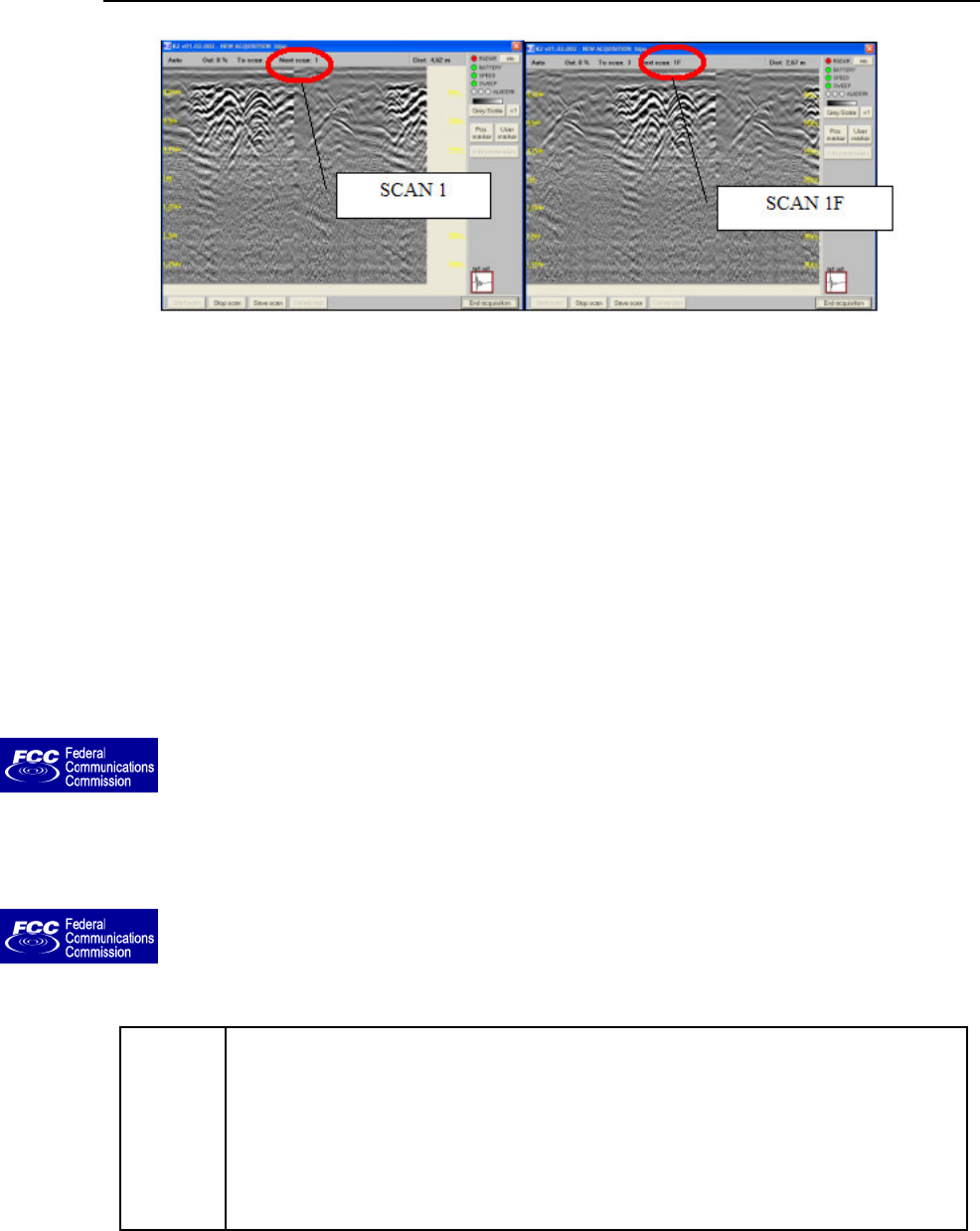
IDS Ingegneria Dei Sistemi S.p.A. Protocol: MN/2005/038 - Rev. 1.2
“ALADDIN SK2 ” STRUCTURE KIT User
Manual
29 / 32
Fig. 4-11 – Sequence of 2 scans using a 2x2 pad
4.2.2 “Manual” Mode
Steps 1-4: Follow the same procedure described for "Automatic"
mode above.
Step 5: Acquis ition starts when you press the START button,
independently of the position of the first horizontal line encountered.
Step 6A (Standard System): Insertion of User Markers during
scanning is performed by rapidly pressing the START button.
Step 6B (US System): Insertion of User Markers during scanning is
performed by rapidly releasing and pressing again the START
button.
Step 7A (Standard System): The scan is STOPPED by keeping the
START button pressed
Step 7B (US System): The scan is STOPPED by releasing the START
button
NO TE!
The system keeps control of data quality (Tolerance
) in both
Automatic and Manual mode. In fact, if this tolerance is
respected, a confirmation acoustic signal is activated; if the
tolerance exceeds the pre-
set percentage during the scan,
an error acoustic signal is heard, the scan isn't saved and you
have to repeat it.
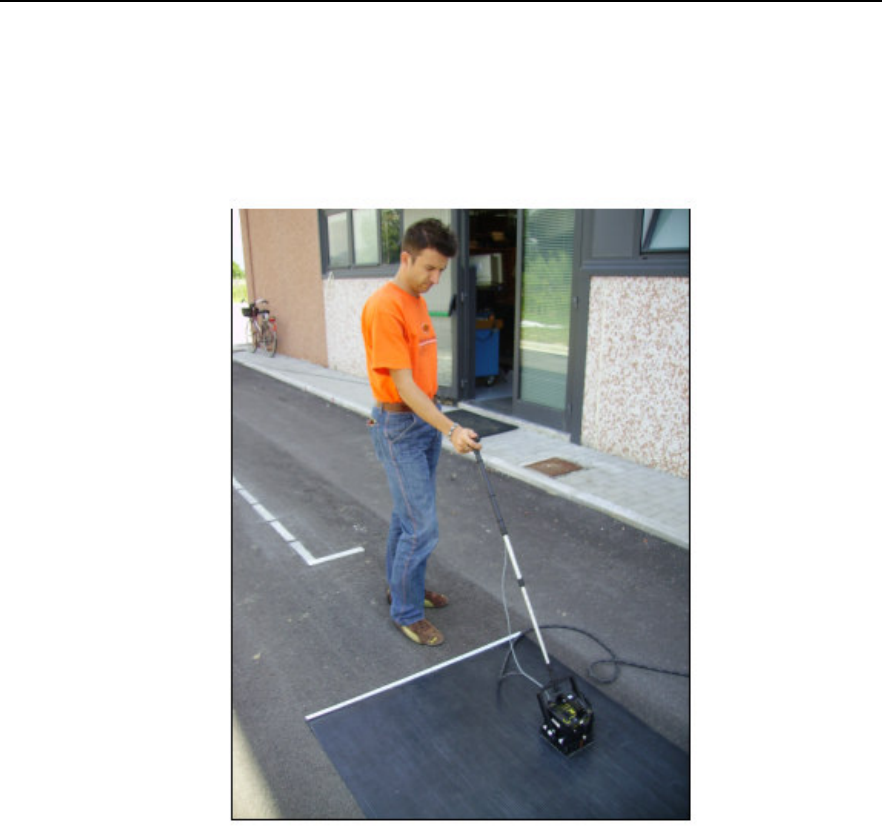
IDS Ingegneria Dei Sistemi S.p.A. Protocol: MN/2005/038 - Rev. 1.2
“ALADDIN SK2 ” STRUCTURE KIT User
Manual
30 / 32
4.2.3 “Manual (no check)” Mode
Step 1-7: In this case the user must use the PSG carpet –Pad Survey
Guide Guide (Fig. 4-12) with the slide applied under the frame (see
Par. 3.2.3).
Fig. 4-12 – PSG Carpet
The PSG carpet holds alternated upper and lower guides in order to
make the slide perfectly fit and for the antenna to realize straight
scans. Also the slide holds a special film on its external surface
removing to the minimum the friction during the drag of the antenna
on PSG. Finally the PSG holds on its edge a graduated horizontal pole
with the indication of numbers and letters in progressive sequence, in
order to give to the user a reference point at the beginning of the scan
(Fig. 4-13).
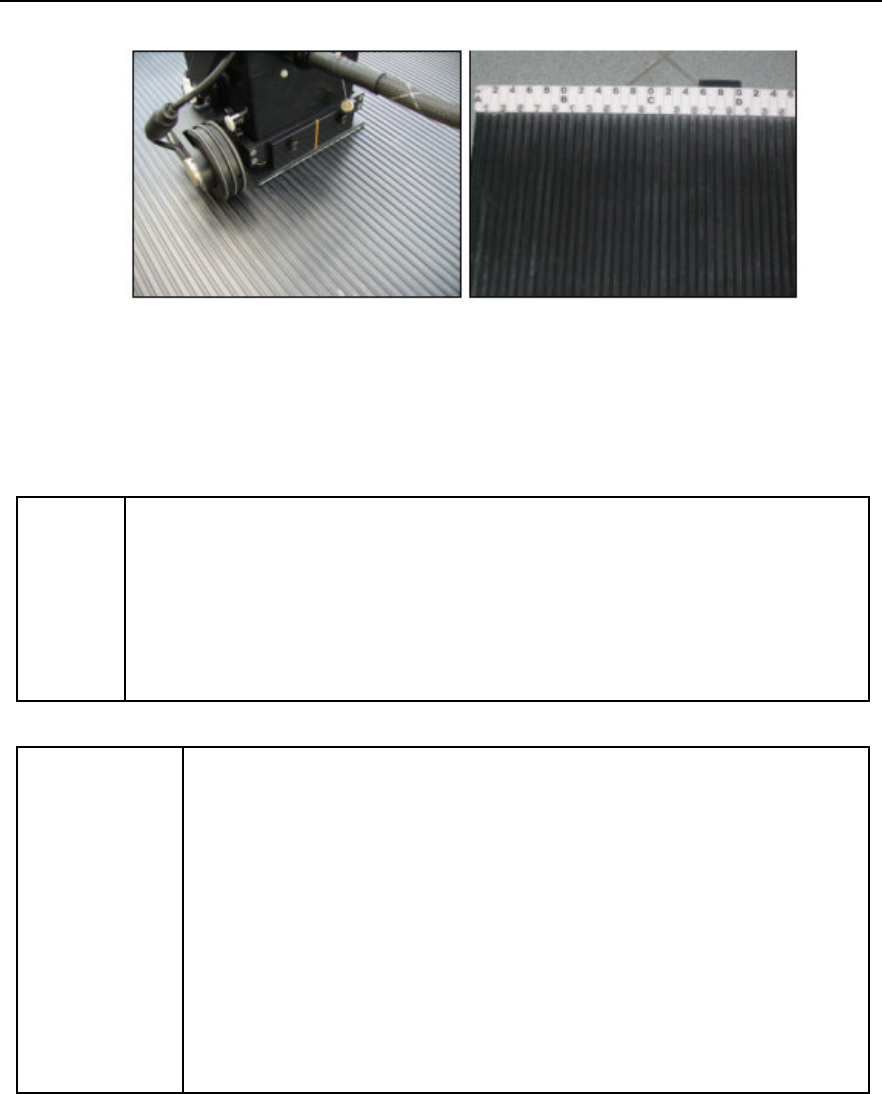
IDS Ingegneria Dei Sistemi S.p.A. Protocol: MN/2005/038 - Rev. 1.2
“ALADDIN SK2 ” STRUCTURE KIT User
Manual
31 / 32
Fig. 4-13 – Features of PSG and slide
Follow the same operative procedure used in the "Manual" procedure
described above.
NOTE!
The main difference with respect to the "Manual" mode consists
in the absence of the Tolerance control factor, therefore you are
free to choose how long the scan should be (Length). This mode
is useful when scan
s of different lengths have to
be performed. This is the only mode in which the user can work
with the optical detector deactivated.
WARNI NG!
Once the scans are finished, you can activate the
Review Acquisition
button (see Par. 4.7 in manual
MN_2004_005); this opens the window shown in Fig. 4-
12, from where pressing the Gred3D button (circled in red),
you can automatically start the GRED 3D NAVIGATOR
SW for the survey underway. The GRED 3D
NAVIGATOR SW can be used to process the raw data as
required.
For information on the GRED 3D NAVIGATOR
SW, see the user manual MN_2005_002.
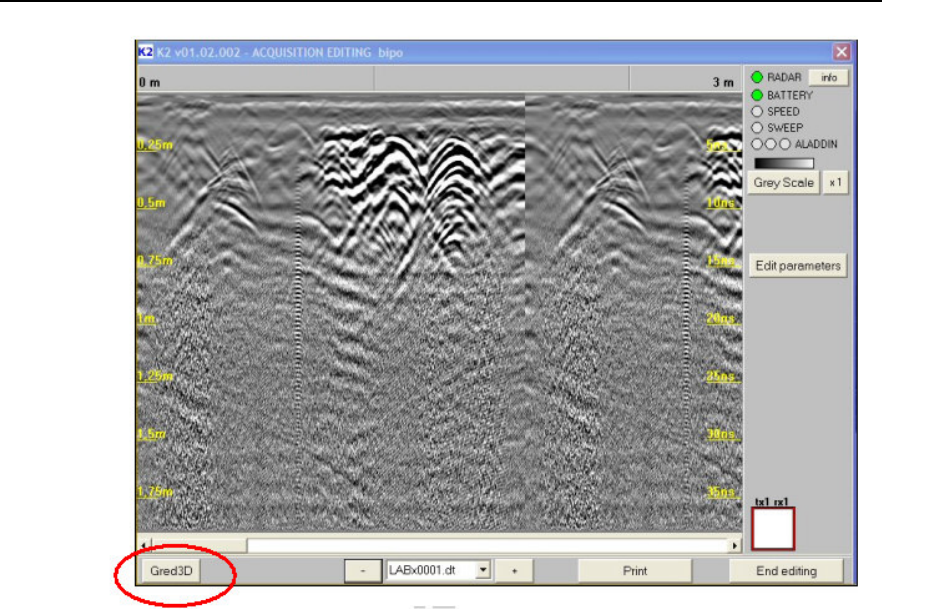
IDS Ingegneria Dei Sistemi S.p.A. Protocol: MN/2005/038 - Rev. 1.2
“ALADDIN SK2 ” STRUCTURE KIT User
Manual
32 / 32
Fig. 4-14 – Gred3D Button